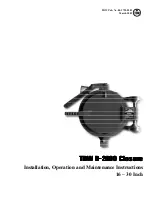
6
BASIC CONNECTIONS AND OPERATION
There are three speaker connections on the connection panel: two standard _
inch jacks and one NL4 connector. These connections are all wired together
in parallel. This means that any of the connections can accept the input from
your amplifier and that the remaining two connections can be used to
connect to additional speaker cabinets if desired.
NEVER CONNECT TWO AMPLIFIERS TO ONE CABINET!
Let us repeat this: NEVER connect two amplifiers, or two channels of the
SAME amplifier, to one cabinet. This is a
Very Bad Thing
which will
damage your amplifiers and possibly the enclosure. It may also result in an
impressive pyrotechnical display –
once
.
You should make all your connections before turning your amplifier on.
Standard _ inch plugs are less than ideal in their ability to transfer the signal
from your amplifier. This is due to the limited amount of actual contact area
in these connections. For best performance, we recommend using NL4 style
speaker connectors. We also recommend using high quality speaker cables
of at least 16 gauge min. (smaller numbers indicate larger cable).
IMPROTANT NOTE:
Using a shielded instrument cable to connect your
amplifier and speakers is a
Very Bad Thing
. DO NOT use shielded
instrument cable for speaker connections unless you want to cause serious
damage to your amplifier.
TWEETER LEVEL CONTROL
The Tweeter Level control is located on the connection panel on the back of
your cabinet. In general we recommend you initially set the control to its
12:00 (or flat) position. Users who aren’t used to having a tweeter in their
bass enclosure may want to turn the tweeter down to the point that it is
barely operating and, over time, slowly adding more tweeter into the mix.
The rear (inside) of the connection panel also houses the crossover and
tweeter protection system. This system uses an aircraft-grade light bulb in a
circuit that is designed to absorb current that is in excess of the power-
handling ability of the tweeter.






























